Layman D. Biology Demystified: A Self-Teaching Guide
Подождите немного. Документ загружается.

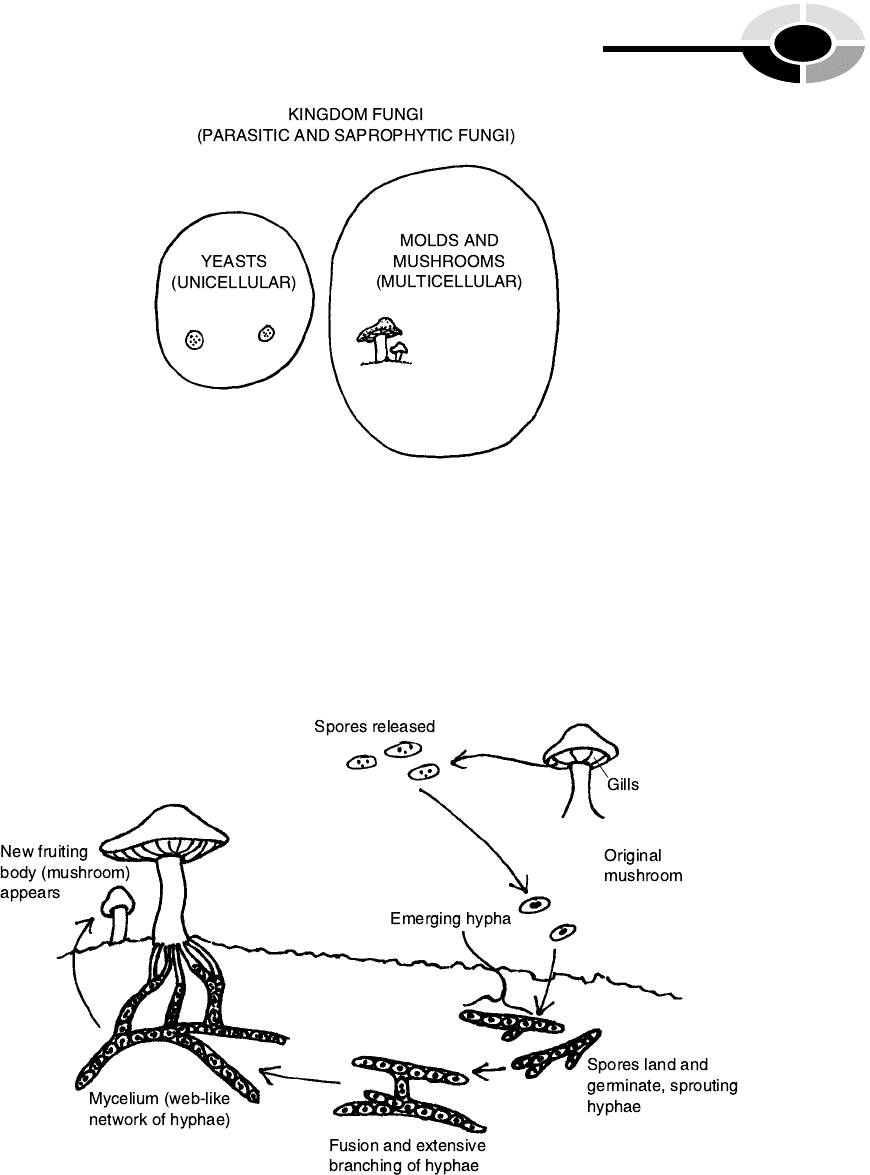
through the air, many of them falling down onto a neighboring area suitable
as a food source. When the spore lands, it sprouts and starts absorbing nutri-
ents. The spore grows out to create a hypha (HIGH-fah), a thin, thread-like
filament. The word, hypha, comes from the Greek for ‘‘web.’’ As its literal
meaning suggests, each individual hypha branches repeatedly in a web-like
manner as it grows. And two adjacent hyphae (HIGH-fee) of different mating
CHAPTER 8 Fungi: Not Just Mushrooms 127
[13:24 13/6/03 N:/4058 LAYMAN.751/4058-Alltext.3d] Ref: 4058 Layman: Biology Demystified All-text Page: 127 1-388
Fig. 8.1 The fungi: A kingdom of molds, yeasts, and mushrooms.
Fig. 8.2 The mushroom as a body plan for a fungus.

types can fuse together and branch even more extensively. The result is a
mycelium (my-SEE-lee-um) or ‘‘fungus nail,’’ actually a web-like network
consisting of thousands of branching hyphae or filaments. The mycelium of
a mushroom is mostly located underground. The mycelium finally pushes up
above the earth, creating the fleshy fruiting body or reproductive structure we
call a mushroom. Quite surprisingly, what we consider a solid mushroom is
actually an extensive web or network of hyphae (filaments), packed tightly
together! And this umbrella-shaped mushroom is just the above-ground fruit-
ing body (reproductive structure) of a much more broad and extensive myce-
lium hidden below the surface. [Study suggestion: Buy some fresh whole
mushrooms and slice them thinly. Using a strong magnifying glass, look for
a network of hyphae or slender filaments within each cap.]
The Major Groups of Fungi
More than 100,000 different species of fungi have been identified, yet mycol-
ogists (my-KAHL-uh-jists) – ‘‘those who specialize in the study of fungi’’
(myc) – usually group all of these species into just four different phyla. The
names of these phyla are very tongue-twisting! Nevertheless, a helpful hint is
that each phylum name ends with the suffix, -mycetes (my-SEE-teez), which
comes from the Greek for ‘‘fungus’’ (mycet). So, look for and recognize
-mycetes, and you know a fungus is somehow involved!
PHYLUM BASIDIOMYCETES (THE CLUB FUNGI)
A good fungal phylum to start with is the Phylum Basidiomycetes (bah-sid-
e-oh-my-SEE-teez). The Phylum Basidiomycetes includes mushrooms,
puffballs, and the shelf fungi often seen growing on the barks of trees.
This particular fungal phylum, then, is quite familiar to those of us who
like to walk through woods and fields (or even stroll through our own
backyard).
The mushrooms get the first part of their phylum name from their basidia
(bah-SID-e-uh) – the ‘‘little bases’’ (basidi) growing out from the gills under
their caps (see Figure 8.3). This group is therefore called the Basidiomycetes
(‘‘little base fungi’’) or club fungi because of the tiny, ‘‘club’’-shaped basidia
present along the edges of their gills. The basidia are important because they
produce the mushroom’s spores, which can be blown off from under the cap
and distributed long distances by the wind.
[13:24 13/6/03 N:/4058 LAYMAN.751/4058-Alltext.3d] Ref: 4058 Layman: Biology Demystified All-text Page: 128 1-388
PART 3 Five Kingdoms of Life, plus Viruses
128
1, Order
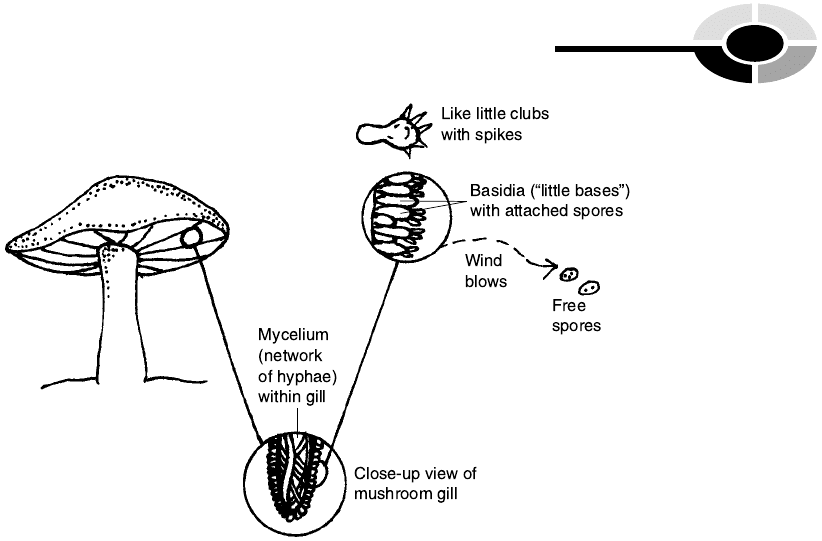
PHYLUM ASCOMYCETES (THE SAC FUNGI)
You might also encounter various members of the Phylum Ascomycetes (as-
koh-my-SEE-teez) or ‘‘leather bag’’ (asco-) ‘‘fungi’’ as you walk through a
forest. This group is commonly called the sac fungi, because they produce
spores within their sac-like or bag-like caps. Consider, for instance, the very
popular morel mushroom, often nicknamed spongy-cap due to the wrinkled,
sponge-like appearance of its cap.
Much less dramatic members of Ascomycetes, however, are the unicellular
yeasts. Yeast cells reproduce by smaller cells budding off and eventually
separating from larger ones. Yeast belonging to the genus Saccharomyces
(sak-ah-roh-MY-seez) are the main ‘‘sugar’’ (sacchar) ‘‘fungi’’ (myc). This
genus of yeasts has been used to help make bread, beer, and wine since
ancient times. The yeast cells are added to raw bread dough or a vat of
grape juice, and they soon begin to consume lots of sugar molecules in the
dough or juice. Initially, these Saccharomyces organisms operate aerobically,
utilizing oxygen. The yeast cells give off CO
2
gas as a waste product, and
these gas bubbles are what make bread dough rise! Later, when the bread is
finally baked, the yeast cells are killed by the high temperature of the oven.
During winemaking, in contrast, the sealed wine vats become anaerobic,
after the active yeast cells consume all available O
2
. The yeast cells then
switch their metabolism from aerobic to anaerobic, and carry out the process
CHAPTER 8 Fungi: Not Just Mushrooms 129
[13:24 13/6/03 N:/4058 LAYMAN.751/4058-Alltext.3d] Ref: 4058 Layman: Biology Demystified All-text Page: 129 1-388
Fig. 8.3 The basidia: ‘‘Little bases’’ or ‘‘clubs’’ on mushroom gills.
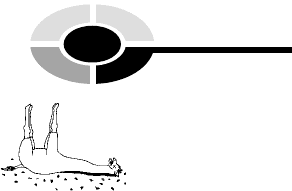
of alcoholic fermentation (fer-men-TAY-shun). By this process, yeast cells
produce both carbon dioxide and ethyl alcohol (common drinking alcohol)
as waste products. When the fermenting wine reaches an alcohol content of
about 12–16%, the yeast cells become poisoned and die from too much
alcohol!
Some common types of molds are also considered members of the Phylum
Ascomycetes (sac fungi). In general, a mold is a fuzzy coating of fungus
growing on the surface of some food or animal or plant substances, when
they are decaying or left for too long in a moist, warm place. A familiar
example of such a fuzzy mold is the genus Penicillium (pen-ih-SIL-e-um),
named from the Latin for ‘‘brush.’’ The Penicillium fungi are bluish-colored
molds growing on bread, fruits, and cheeses. They have a somewhat brush-
like appearance under the light microscope, and several Penicillium species
produce penicillin, the powerful, bacteria-killing, antibiotic drug.
PHYLUM ZYGOMYCETES (THE ZYGOTE FUNGI)
A third group of fungi are those of the Phylum Zygomycetes (zeye-go-my-
SEE-teez), literally the ‘‘yoked together’’ (zygo-) ‘‘fungi.’’ This phylum of
fungi derives its name from the inclusion of a zygote (ZEYE-goat) within
its life cycle. A zygote consists of two sex cells, called gametes (GAM-eats),
that are literally fused, yoked, or ‘‘married’’ (gamet) together during fertiliza-
tion.
The so-called zygote fungi in this group utilize sexual reproduction – the
fusion of two gametes together to create a zygote. Once formed, the zygote
then divides repeatedly by the process of mitosis (Chapter 5), thereby creating
a new adult organism. The zygotes are enclosed in thick-walled zygospores
(ZEYE-go-spoors), which are shed and sent wafting out through the air to
new locations.
A typical zygomycetic (zeye-go-my-SEE-tick) fungus is the black bread
mold, genus Rhizopus (RYE-zuh-pus) – ‘‘root’’ (rhiz) ‘‘feet’’ (pus).
Interestingly enough, like many fungi, the Rhizopus group can engage in
both sexual reproduction (gametes uniting to form zygotes), as well as asex-
ual (AY-sex-you-al) reproduction that occurs ‘‘without’’ (a-) gametes. For
simplicity, just the asexual reproduction of the black bread mold is displayed
in Figure 8.4.
A spore lands on a piece of white bread, then begins to germinate (JER-
muh-nayt). The landed spore ‘‘sprouts’’ a number of slender, thread-like
hyphae, which soon merge to form a white, extensively branching mycelium,
deep inside the bread slice. Soon, a large number of round-topped sporangia
[13:24 13/6/03 N:/4058 LAYMAN.751/4058-Alltext.3d] Ref: 4058 Layman: Biology Demystified All-text Page: 130 1-388
PART 3 Five Kingdoms of Life, plus Viruses
130
2, Disorder

[13:24 13/6/03 N:/4058 LAYMAN.751/4058-Alltext.3d] Ref: 4058 Layman: Biology Demystified All-text Page: 131 1-388
(spoh-RAN-jee-ah) or ‘‘seed’’ (spor) ‘‘vessels’’ (angi), appear like tiny black
puffballs. The round, black sporangia are attached to the bread surface by
long, narrow stalks. The mold is called Rhizopoda, because the sporangia
and their stalks are firmly anchored into the bread surface by means of
rhizoids (RYE-zoyds) – blunt, ‘‘root-resembling’’ or ‘‘foot-resembling’’ pro-
jections. When the wind blows, masses of black spores are scattered from the
rounded sporangia, which hold thousands of them. A spore may land on
another piece of bread, and the life cycle of the mold begins anew.
PHYLUM CHYTRIDIOMYCETES (WATER-DWELLING
FUNGI)
A fourth phylum of fungi is the Phylum Chytridiomycetes (KIH-trid-e-oh-my-
SEE-teez) or ‘‘water-dwelling’’ (chytrid) ‘‘fungi.’’ The members of this group
with an extremely tongue-twisting name are more easily called chytrids (KIT-
rids), because they are mainly ‘‘water-dwellers.’’
Recent evidence suggests that the chytrids are the most primitive fungi,
and that they were the first type to evolve from protists having flagella.
CHAPTER 8 Fungi: Not Just Mushrooms 131
Fig. 8.4 The asexual life cycle of Rhizopus or black bread mold.

Dwelling in an aqueous (watery) environment, each chytrid has a small,
globe-shaped body. It produces a highly active spore which has a flagellum
attached. In their adult stage, the chytrids make a large mycelium (network)
consisting of an extensive tangle of slender hyphae. These highly branched
hyphae create a large area for the easy absorption of nutrients dissolved in
the surrounding water.
Summary diagram of the fungi
Figure 8.5 provides summary pictures and brief descriptions of each of the
four major phyla of fungi we have been studying.
[13:24 13/6/03 N:/4058 LAYMAN.751/4058-Alltext.3d] Ref: 4058 Layman: Biology Demystified All-text Page: 132 1-388
PART 3 Five Kingdoms of Life, plus Viruses
132
Fig. 8.5 A summary of the four major phyla of fungi.
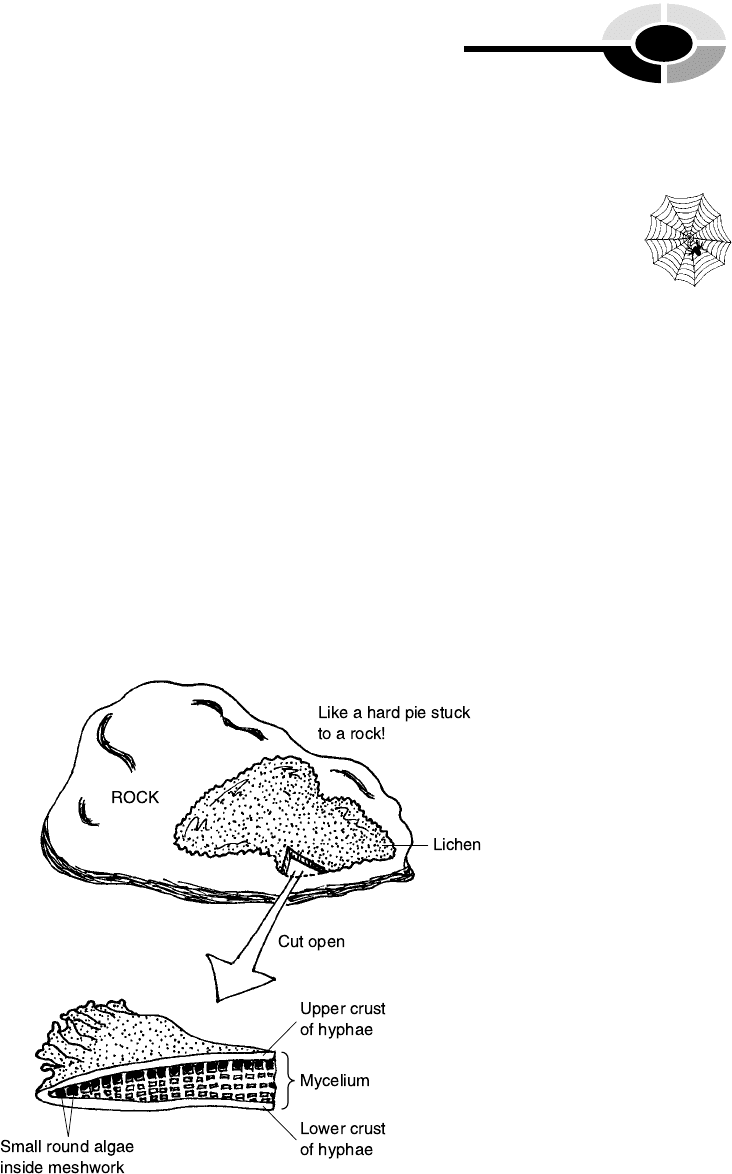
The Lichens: Where Fungi Mix with Algae
Another unusual group closely related to the fungi are the lichens (LIE-kens).
This term derives from ancient Greek and originally meant, ‘‘that which licks
or eats around itself.’’ Lichens are mixtures of fungi with either algae or
bluish-green bacteria, living together in symbiosis (Chapter 7), such that
each type of organism benefits.
Because they contain photosynthetic algae that produce chlorophyll,
lichens may look like greenish moss growing on a rock or tree trunk.
Lichens are not green plants or really any other type of single organism.
Lichens are constructed somewhat like a tough, stale, blueberry pie containing
two different types of organisms (Figure 8.6). Like a pie, there is a protective
upper and lower crust of slender, tightly packed hyphae (the fungus partner).
As in the fruiting body (cap and stem) of a mushroom, the middle of the lichen
consists of a mycelium – a loose network of highly branched, thread-like
hyphae. Finally, like thousands of blueberries baked into a pie, small round
algae are inserted into the meshwork of the fungus mycelium.
This relationship is symbiotic (sim-beye-AHT-ik) because the fungal crusts
are tough enough to protect the contained algae from extremes of climate
CHAPTER 8 Fungi: Not Just Mushrooms 133
[13:24 13/6/03 N:/4058 LAYMAN.751/4058-Alltext.3d] Ref: 4058 Layman: Biology Demystified All-text Page: 133 1-388
2, Web
Fig. 8.6 The lichen as a slice of blueberry pie.

and temperature. The fungus also releases enzymes that partially digest rock
or other hard surfaces, allowing nutrients to be absorbed by the lichen. In
return, the algae produce additional energy for their fungal partners by
carrying out photosynthesis. Thus, lichens make an extremely tough duo
of cooperating organisms that, working together, can survive in some of
the harshest habitats on planet Earth. Brave hikers can see them tightly
clinging to rocks at the tops of frozen mountains, or even thriving in the
empty wasteland of Antarctica!
Parasitic Fungi and Their Victims
Since certain fungi are parasites, it is only to be expected that some will cause
the disease or death of their infected hosts. And those that are potentially
pathogenic are nearly impossible to escape, because fungal spores float in the
air, almost everywhere! [Study suggestion: Take the lid off an unwanted jar of
jelly and leave it open. Soon, you will see the surface completely covered with
a fuzzy substance. To what particular phylum in the Kingdom Fungi, do you
think this fuzzy coating belongs? Its spores may have been produced and
shed many miles away from you!]
FUNGAL PARASITES OF PLANTS
Most of the parasitic fungi attack plants. Dutch elm disease, for instance, is
due to a sac fungus (Phylum Ascomycetes) that was accidentally brought into
the United States by infected logs from Europe during World War I. (The
disease gets its Dutch name from the fact that it was first observed in Holland
in 1919.) Spread from tree to tree by bark beetles, Dutch elm disease has
eliminated thousands of native elm trees across the Continental U.S.
Every year, grain farmers lose billions of dollars of crops to fungal infec-
tions. One grain infection with especially important implications for human
health is ergot (ER-gaht), a small black sac fungus in the seed heads of wheat
or rye plants. If any unwary humans or farm animals are so unfortunate as to
eat such infected grain plants, they may come down with ergotism (ER-goh-
tizm). During the Middle Ages in Europe, ergotism was quite common and
was given the alternate name, St. Anthony’s fire. People ate a diet heavy with
rye and other natural grains baked in their bread. Although baking killed the
fungus, it simply released its toxins into the bread. Such poisoning results in
vomiting, cramps, great thirst, and burning in the abdomen. (Hence the old
[13:24 13/6/03 N:/4058 LAYMAN.751/4058-Alltext.3d] Ref: 4058 Layman: Biology Demystified All-text Page: 134 1-388
PART 3 Five Kingdoms of Life, plus Viruses
134
1, B-Web
2, B-Web
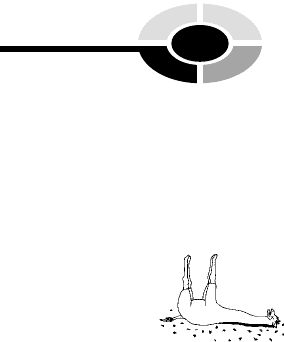
name, St. Anthony’s fire.) Happily, modern grain processing techniques clean
the ergot fungus from wheat and rye, so that ergotism is rare.
FUNGAL PARASITES OF HUMANS
Records show that when patients go to a hospital and accidentally acquire an
infection, it is more likely to be a fungal infection than one of bacteria or
viruses! And the offending parasite is most likely to be Candida (KAN-dih-
dah) albicans (AL-bih-kans), a ‘‘glowing white’’ (candid) fungus. A close
relative of the yeasts, Candida albicans is a common inhabitant of the
human mouth, skin, intestine, and vagina.
Candidiasis (kan-dih-DIE-ah-sis), or an ‘‘infestation with’’ (-iasis) Candida
fungus, tends to occur whenever the number of these fungi in the human
body becomes very excessive. This may happen when a person is given a
long-term regimen of antibiotics or steroid drugs, which depresses the activity
of the immune (self-defense) system. Whenever too many competing organ-
isms (such as bacteria) are killed off, or whenever the immune system
becomes too weak, this leaves the door wide open for Candida albicans to
overpopulate part of the body and cause a problem. Scattered white patches
appear in infested areas, such as the female vagina, along with an inflamma-
tion. This is a common cause of vaginitis (vaj-in-I-tis) – ‘‘inflammation of the
vagina’’ – in women of reproductive age.
Quiz
Refer to the text in this chapter if necessary. A good score is at least 8 correct
answers out of these 10 questions. The answers are found in the back of this
book.
1. Saprophytic fungi:
(a) Absorb small molecules from the cells of living hosts
(b) Are not common enough to be worth studying
(c) Release enzymes that partially digest dead tissues
(d) Are named from their habit of feeding upon the sap leaking from
injured trees
2. A key difference between fungi and slime molds:
(a) Some fungi are parasites of living organisms
(b) Most slime molds act as parasites of living hosts
CHAPTER 8 Fungi: Not Just Mushrooms 135
[13:24 13/6/03 N:/4058 LAYMAN.751/4058-Alltext.3d] Ref: 4058 Layman: Biology Demystified All-text Page: 135 1-388
3, Disorder

(c) Fungi obtain nutrients by digesting and absorbing organic matter
(d) There are far more species of slime molds, than of fungi
3. The entire group of unicellular fungi:
(a) Molds
(b) Yeasts
(c) Morels
(d) Lichens
4. The fruiting body of a mushroom:
(a) Its extensive underground mycelium
(b) Spores released into the air
(c) A dense web of hyphae projecting above ground
(d) The sweet, cool part that always tastes like an apple!
5. The fungal phylum to which morel mushrooms belong:
(a) Zygomycetes
(b) Basidiomycetes
(c) Chytridiomycetes
(d) Ascomycetes
6. The basidia are important to a mushroom, since they:
(a) Directly absorb nutrient molecules from decaying organic matter
(b) Produce and hold its spores
(c) Branch extensively underground
(d) Allow the fruiting body to be efficiently removed
7. Phylum of fungi involving the union of two gametes:
(a) Ascomycetes
(b) Chytridiomycetes
(c) Zygomycetes
(d) Basidiomycetes
8. Probably the most primitive group of fungi, and the first to evolve from
protists:
(a) The chytrids
(b) Ascomycetes
(c) Zooplankton
(d) Bread yeasts
9. Penicillium:
(a) Releases thick-walled zygospores
(b) A bluish-colored genus of mold that produces powerful
antibacterial agents
[13:24 13/6/03 N:/4058 LAYMAN.751/4058-Alltext.3d] Ref: 4058 Layman: Biology Demystified All-text Page: 136 1-388
PART 3 Five Kingdoms of Life, plus Viruses
136
